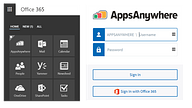NEW support for VMware Horizon and more AppsAnywhere updates

This week marks the official release of AppsAnywhere v2.2 and some major updates, including support for new application delivery methods.
Powered by S2Hub, AppsAnywhere's goal is to get software to students. Period. Students don't care what delivery method university IT uses to deliver their software, as long as they can access apps easily and that they run at warp-speed.
That's why we integrate with mutliple app delivery technologies, such as Cloudpaging, App-V and SCCM. And from this week we're thrilled to add another one into that mix: VMware Horizon.
What's new in AppsAnywhere? Update Webinar
Watch the recording of our recent webinar and find out more about the latest version of AppsAnywhere. This webinar covers a brief overview of AppsAnywhere, a detailed look at the problems it solves, delivery methods and Smart Prioritization, new features for July 2017 (including VMware integration) and a sneak-peak at what's coming later this year...
VDI just got awesome.
S2Hub now gives IT the ability to deploy remote apps running in a VMware Horizon environment through AppsAnywhere. And for the first time, students can now deploy desktops from directly within AppsAnywhere!
We recognize that customers across North America and Europe are using VDI to deliver apps to students in certain circumstances. So instead of having to direct staff and students to multiple portals to get different apps (which can be confusing!), we've built an integration with VMware Horizon.
That means the end user can get all their apps from one place, regardless of the technology that's being used to deliver the application. And that one place is easy-to-use, customizable and intutitive, with a recognizable 'app store' user interface.
More features of AppsAnywhere v2.2

Detection of locally-installed apps
S2Hub now has the ability to detect apps that are already installed on the user's device, and launch them at a click of a button in AppsAnywhere. And thanks to Smart Prioritization, university IT can set this as the first choice delivery method, without the user even needing to know how their software is being delivered.

Azure AD single sign-on (SSO)
Sign in once to any Office 365 app and you'll automatically be signed into AppsAnywhere. Students can now access AppsAnywhere from within the Office 365 dashboard, too.


Third Party client management
It seems like everyone has a client that needs to be installed these days. If your institution is using lots of different delivery technologies then this can turn into a nightmare for BYOD users; they just want to launch a couple of apps!
AppsAnywhere has expanded its management of Third Party clients, so that the administrator can decide exactly which ones their users need and when they should be installed. The best bit is, the user doesn’t need to lift a finger, it’s all managed for them so that their apps are ready to go.
Currently supported Third Party clients are Cloudpaging Player and VMware View.